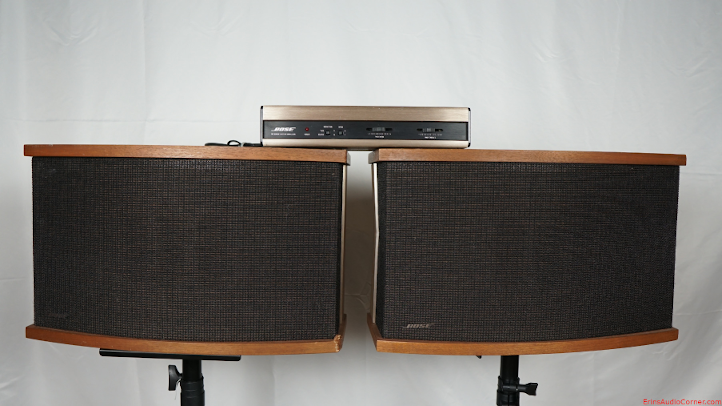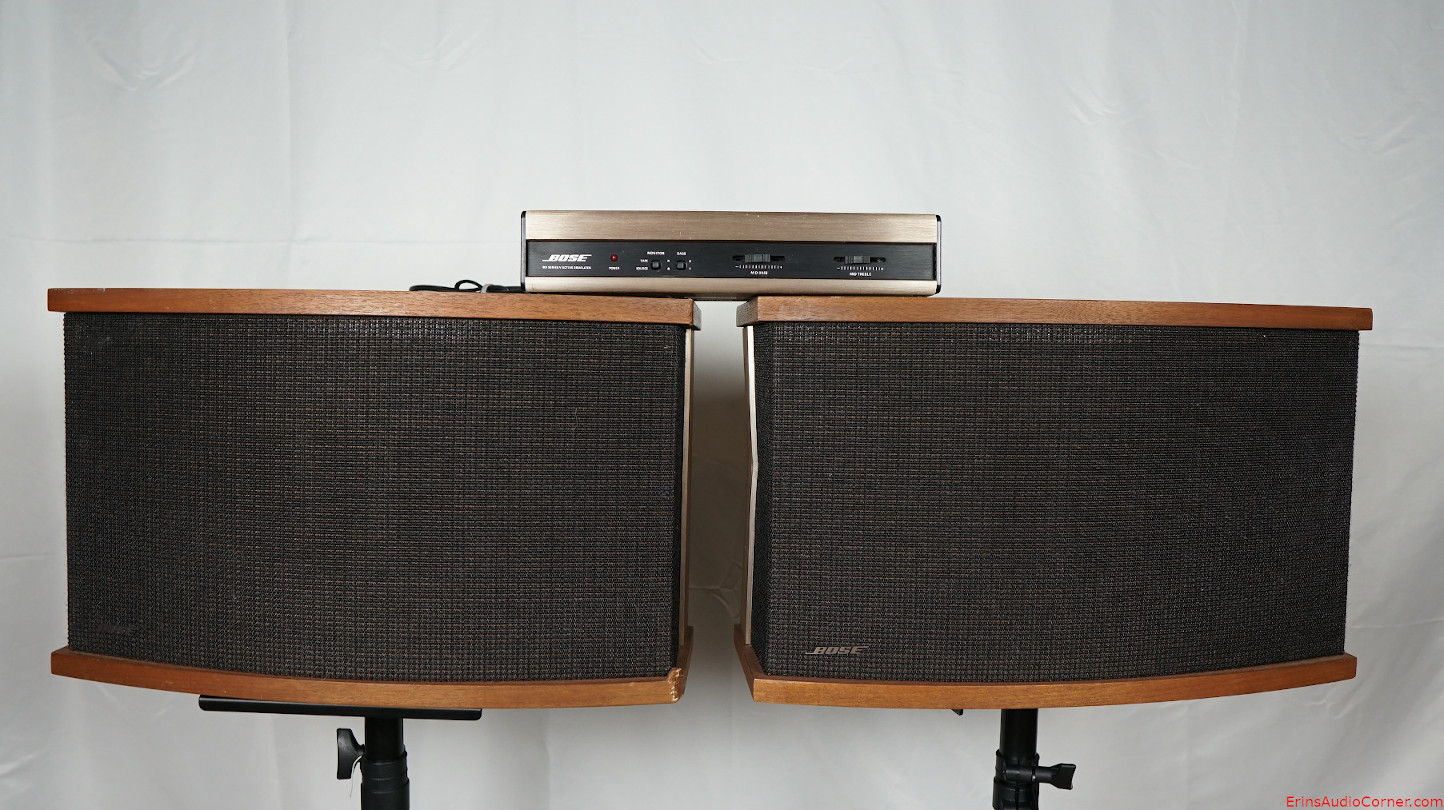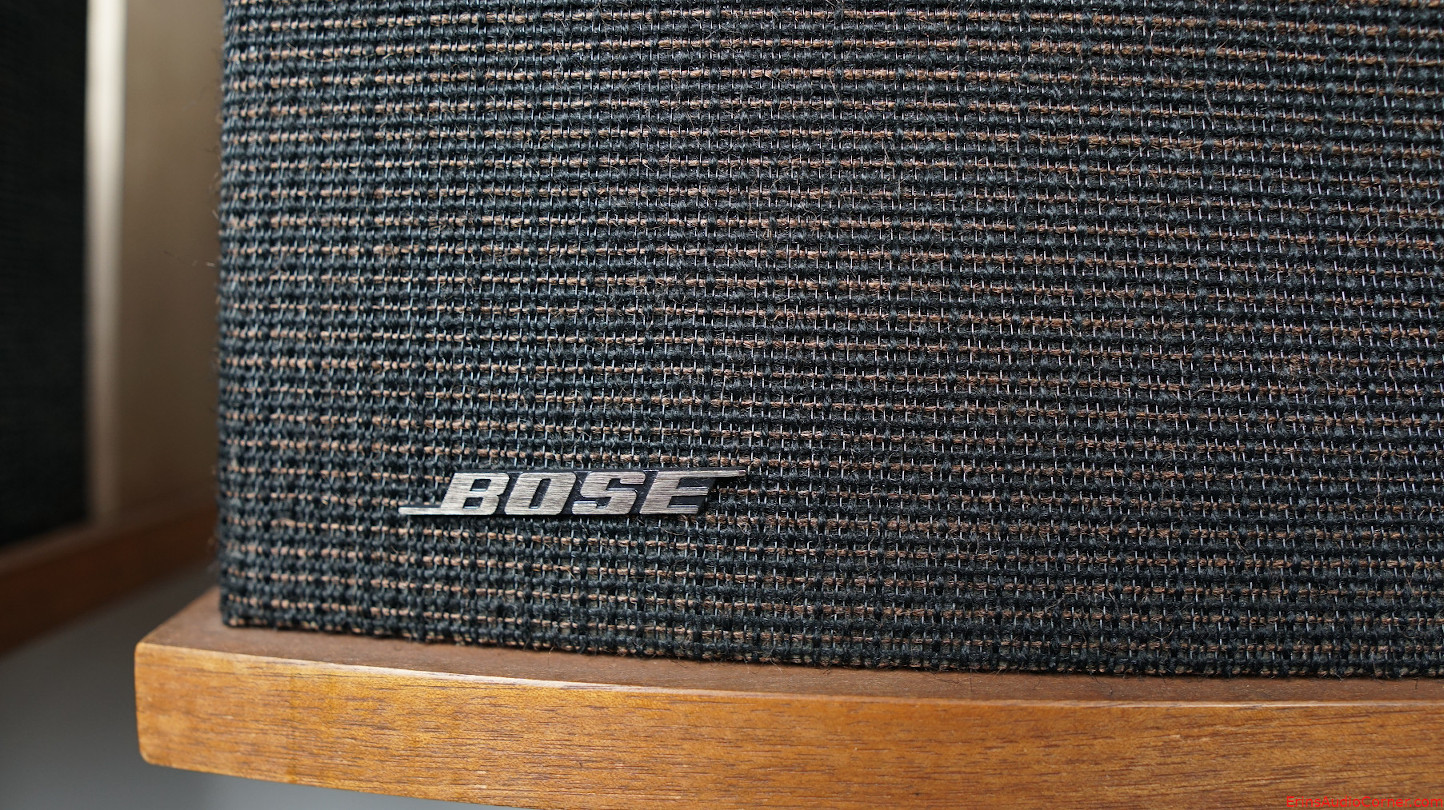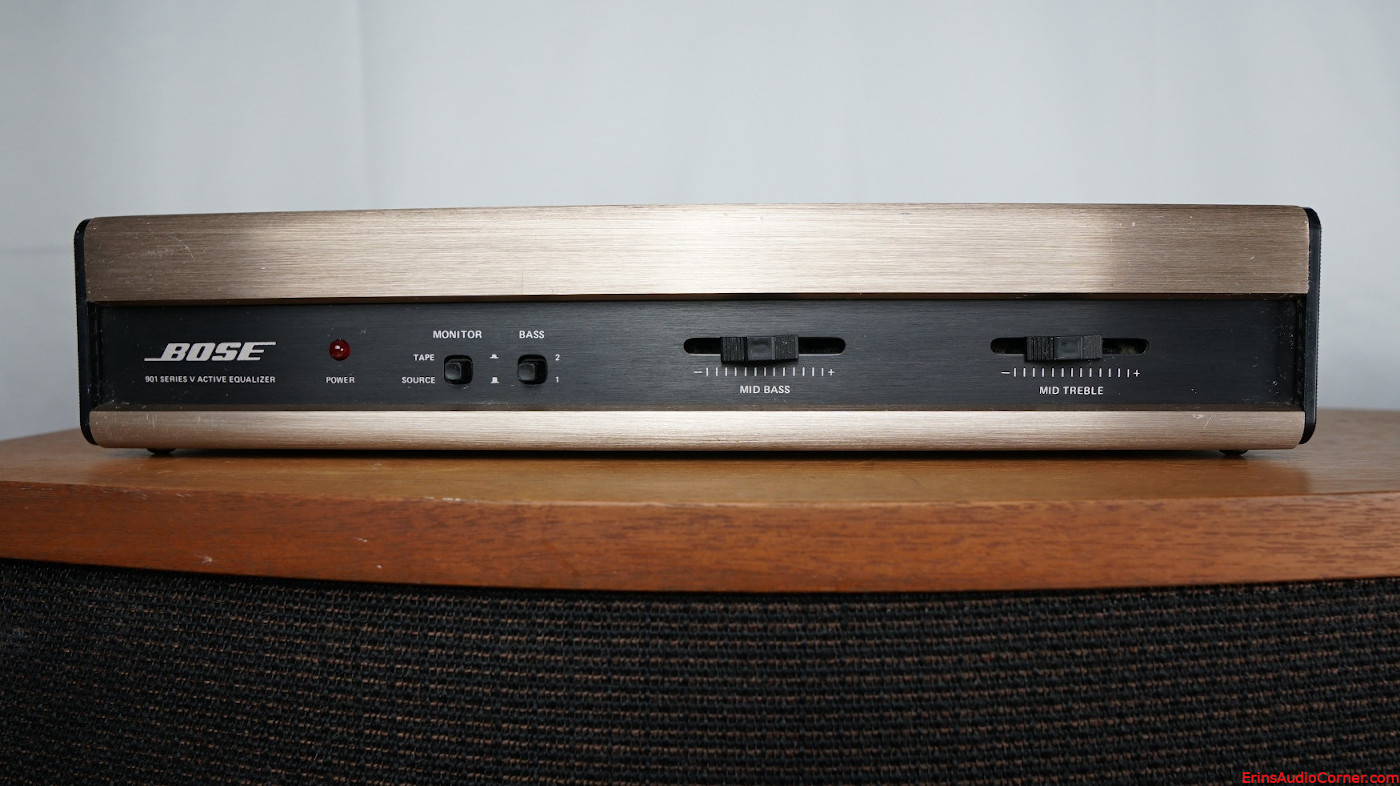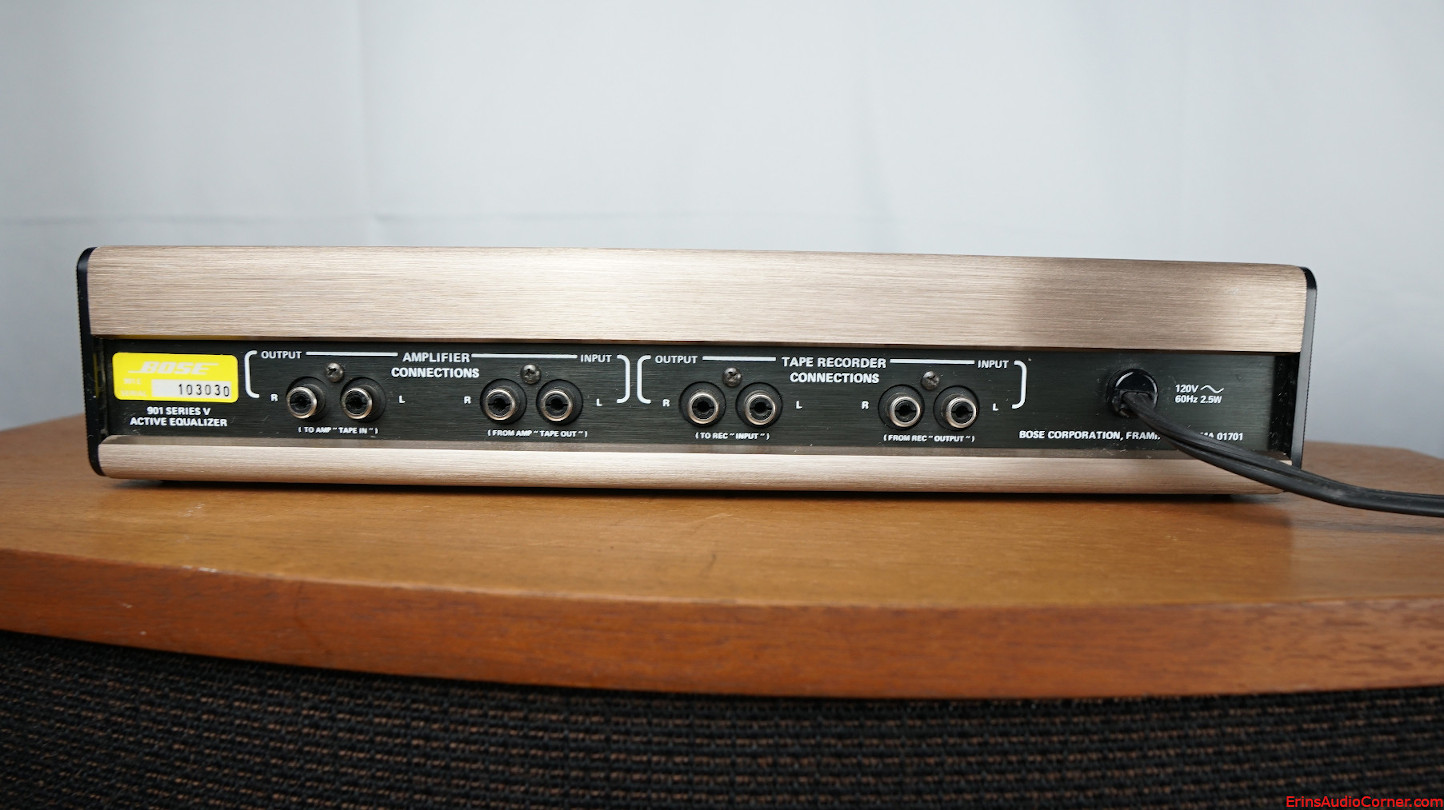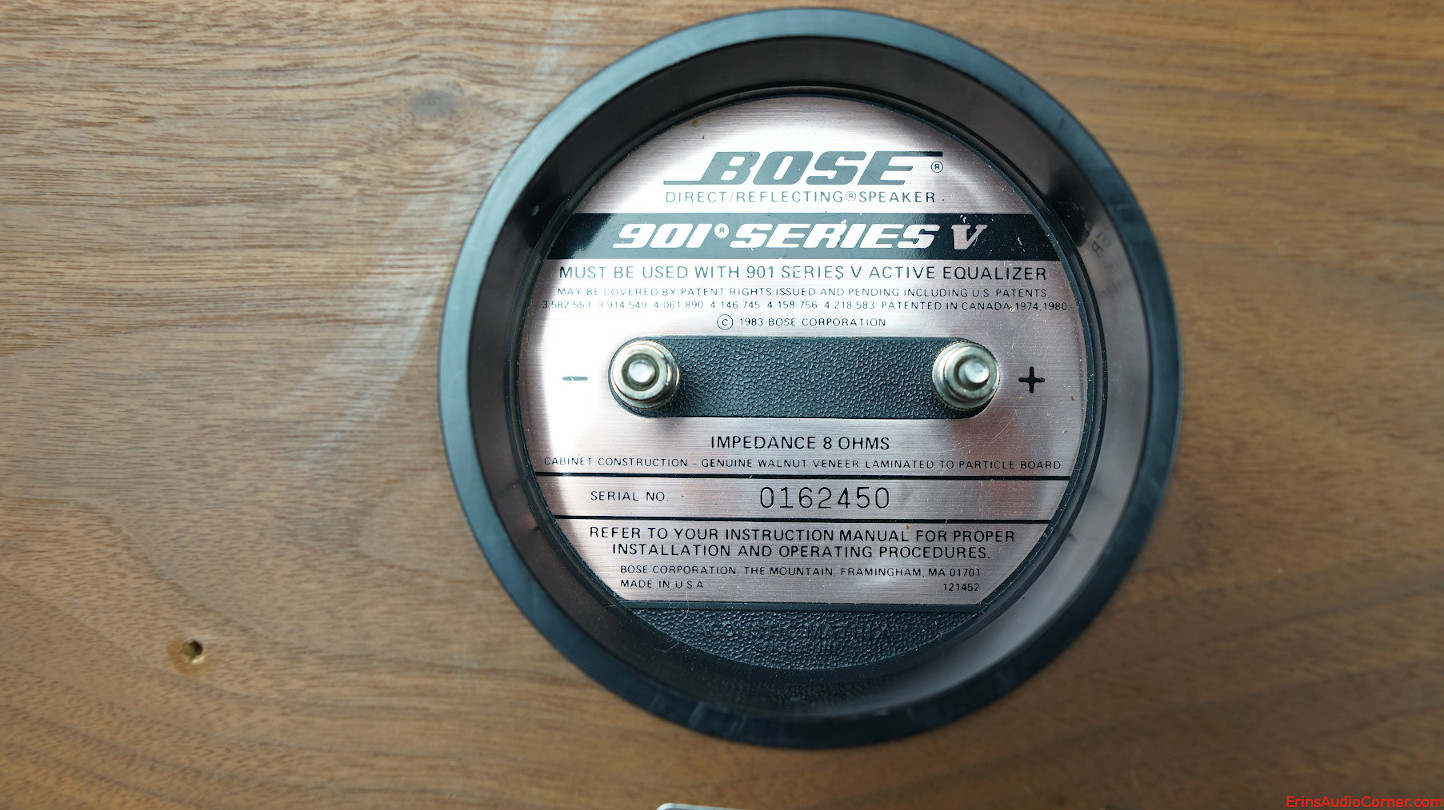YouTube Video Review version:
Intro
A few things that need to be stated up front before people skip this and go to the pictures:
- Pay attention to the Title of each graph. This speaker comes with an EQ that has all sorts of various slider positions. I tested the speaker “Raw” (without the EQ in-line) first. Then I tested it with the EQ in-line, with a few different setting configurations. There is a lot to unpack here. The title of each graph tells you how the settings were made. Please pay attention to the titles; otherwise you will get confused as to what is going on.
- Some may be concerned that this “Spinorama” data doesn’t take in to affect the speakers needing to be close to a surface. I have attached an image below but to summarize: The speakers should be placed at least 18 inches from side walls (with a recommendation of 2-4 feet from side walls) and 8-16 inches from the rear wall. The “Spinorama” data does not take this into account. And, at this point, I do not know how to manipulate the data in a way to “trick” the Spinorama graphics in to showing what would happen when you place them in the manner they were designed to be placed. Although, one can make the case that the SPL is simply adjusted by +6dB for this proximity and transition from the standard 4-pi reference to a 2-pi reference (free space vs near-wall). That’s just the reality. So, before anyone gets up in arms about this factor; yes, I am fully aware of the potential limitation related to this speaker’s direct/reflective design.
- The EQ was always in-line in my listening sessions.
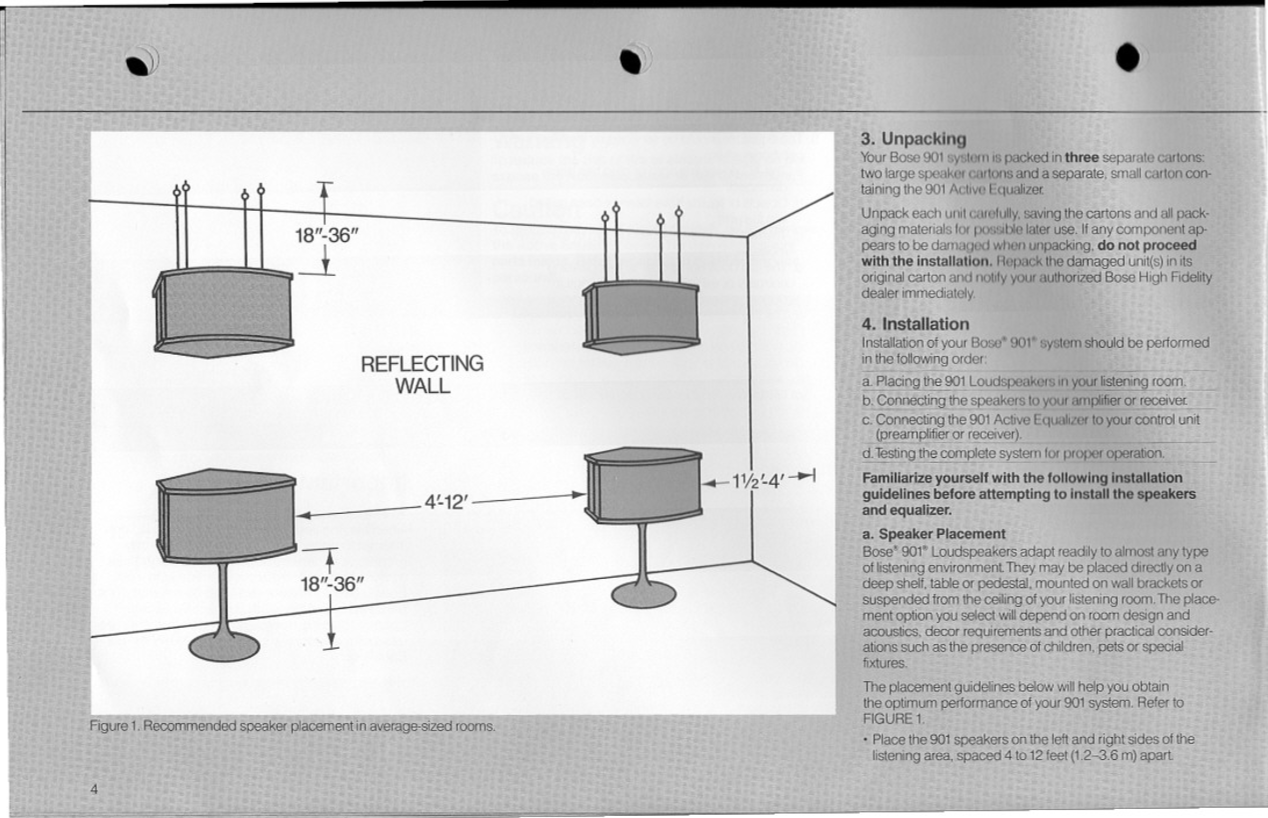
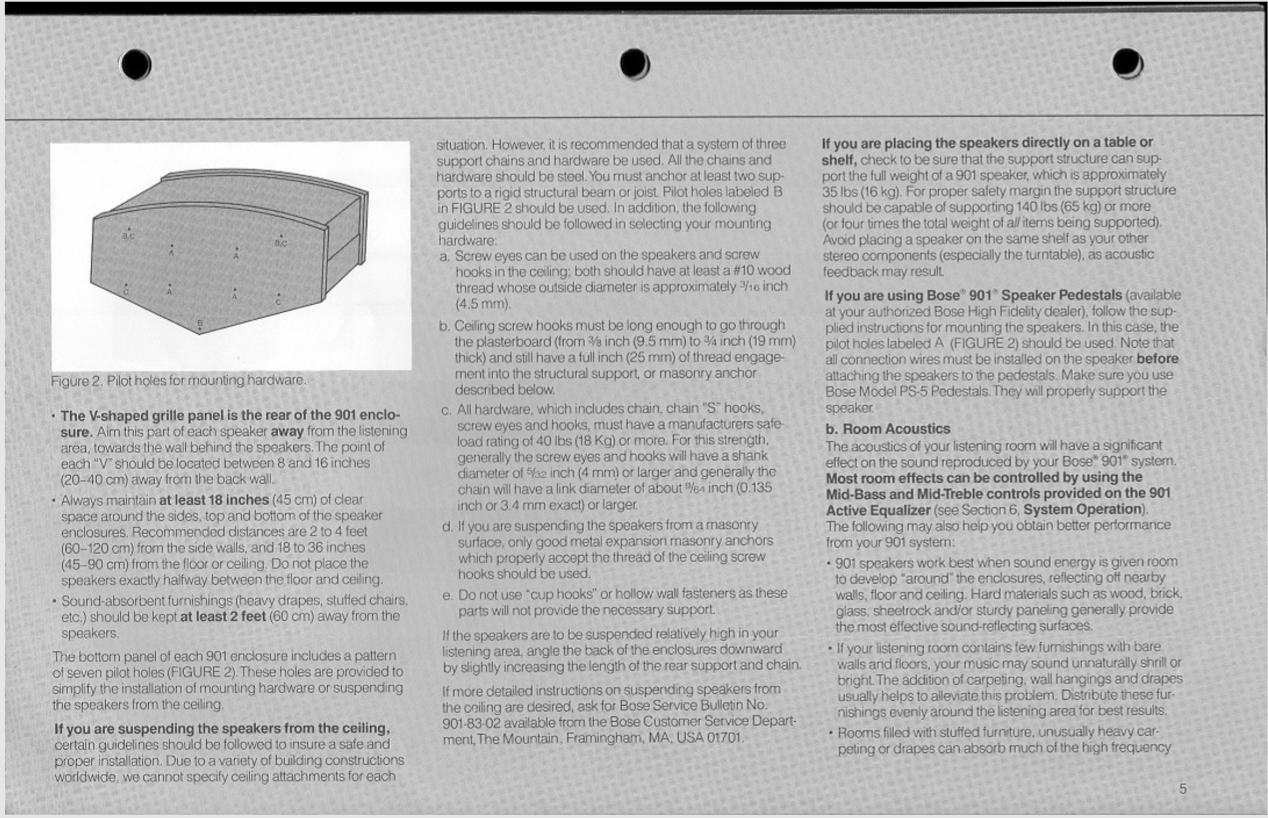
Moving on…
The Bose 901 has been around for 50+ years and has long been considered a divisive product within the audiophile community. I was born in 1982 and until this week I had never heard the Bose 901 speakers. I’d just heard about them. Everything we all have heard and read. The same old clichés. Some love them. Some love the nostalgia of them. Some despise them and everything they represent; from the company to the product performance and how it colors (no pun intended) listeners’ perception of what good sound is supposed to be.
There have been some who have provided measurements of these speakers (NoAudiophile did here). However, there are no measurements that replicate anechoic data. Additionally, with the gaining popularity of the CEA/CTA-2034 method of providing a complete set of measurements and a prediction for in-room performance based on Floyd Toole’s work, I couldn’t stop wondering not only how the 901 would sound to me but also how they would fare in the CTA-2034 standard set of curves. Long story short, a fellow forum member of AudioScienceReview was kind enough to send me his pair of Bose 901 Series V speakers. Funny side story: he was going to send the Series IV he owned but had issues when it came time to refoam them so he sourced a very good condition pair of Series V’s and shipped them to me. Given the Series VI is the last production model and that the Series V and IV (apparently) only differ in cosmetic fashion, I was happy to have the “latest” 901 version to test.
This version consists of a single “full range” 4.5 inch driver up front and 8… yes, 8… 4.5 full range drivers in the back. The idea is to place these near a rear-wall and the 8 speakers in the back would create an enveloping sound. Well, they certainly do that. But, as you can imagine, they are not what I would consider accurate or reference speakers. Still, they’re novel and I rather enjoy the novelty. I get why people hate them. I also understand why people love them. If I had endless money and space, I’d love to have these in a dedicated room as an alternative to a reference system. Something to go in to, plop down in a big comfy chair and just kick back and enjoy these for what they are: a novelty speaker that does bring a grin to my face.
I’ll get back to my subjective thoughts later but for now let’s move on to the data.
Foreword: Subjective Analysis vs Objective Data (click for more)
If you have seen my past reviews, you know that I am of the mindset that objective data is at least as important as someone's subjective evaluation of a speaker. If not more. Why? Because every room is different. Every listener is different. Some know what to listen for. Others know what they want to hear based on their own preference (i.e., some prefer extended bass, some prefer more midbass punch between 120-150Hz, some prefer a response with a dip around 4kHz, etc., etc.). What one person wants or expects may be opposite of another. Additionally, the room will impact the performance and therefore what the listener hears. This means when you read another's subjective-only review you are left to resolve those variables on your own. That's not likely to happen. Unless there is objective data you can use to get an idea of the performance. With objective data you can begin to understand why the subjective review turned out the way it did. Notably, objective data keeps reviewers honest. It's hard for a reviewer to legitimately bash one product but elevate another when the two measure practically the same in every regard. Not to say two similarly measuring speakers cannot subjectively sound different. Though, odds are if they do measure the same then a huge subjective difference is most likely attributed to other issues such as setup conditions, bias, etc. Objective data is the key to accountability. Simply put: if the measurements are taken with care and you understand them, you can rely on data to help paint a more accurate description of performance than a few adjectives from your favorite reviewer (myself included). As you will see, objective measurements can provide a lot of insight in to how the speaker will perform in your room.However, when possible, it is always best to demo speakers in your own room. Not simply because of subjective performance. But because of other factors such as aesthetics, pride of ownership, etc. In my experience, all these factors play in to how the listener “connects” with the system. A good shop or manufacturer understands this and allows buyers to try items out at home before purchasing or they offer a reasonable return policy. If you question the performance and can demo the speakers in your own home, I suggest you take advantage of the opportunity.
For all the reasons listed above: What I provide here is objective-heavy analysis. I still provide my own subjective experience but with in-room measurements at my listening position(s) so we can understand why I heard what I heard. Is it the room, the actual speaker itself, my brain, or a combination?
Now that you understand my motives, let’s get started with the review.
Product Specs and Photos
Objective Data
Before I dive into the test, let me reiterate the fact this speaker has a multitude of EQ options. I tested the speaker “raw”, primarily. I also tested with the EQ in-line varying the settings. So, again, please read the title of each graphic because these tell you what was measured in that particular instance.
When the graph says “No EQ” that means there was No EQ In-Line for the measurement. In other words, this is a raw speaker measurement.
Unless otherwise noted, all the data below was captured using Klippel Distortion Analyzer 2 and Klippel modules (TRF, DIS, LPM, ISC to name a few). Most of the data was exported to a text file and then graphed using my own MATLAB scripts in order to present the data in a specific way I prefer. However, some is given using Klippel’s graphing.
EQ Box Testing
I used Klippel’s Distortion Analyzer 2 to capture the Bose 901 Series V’s various EQ settings. As you can see from the above photo of the EQ box there are various slider positions for “Mid Bass” and “Mid Treble”. There is also a “Bass” setting which accentuates the lower bass. I have provided two graphics below showing 1) difference between “Bass 1” and “Bass 2” (when EQ is set to the Neutral position) and 2) the comparison of the MidBass and MidTreble sliders (with Bass = 2).
As you can see below, the “Bass” button boosts the LF response another 5dB or so.
/Bose 901 Series V Equalizer Settings Bass1 vs Bass2.png)
These are a sampling of the various EQ slider positions, where Bass = 2. The yellow line is the “EQ Neutral” setting; meaning the EQ sliders were at the middle detent … I also refer to this as “flat”, even though it’s not electrically flat… it’s just the default setting. As you can see, there is a lot of swing available on both ends and the 1kHz region is the closest to the same any of these settings comes to.
/Bose 901 Series V Equalizer Settings.png)
Impedance Phase and Magnitude
Impedance measurements are provided both at 0.10 volts RMS and 2.83 volts RMS. The low-level voltage version is standard because it ensures the speaker/driver is in linear operating range. The higher voltage is to see what happens when the output voltage is increased to the 2.83vRMS speaker sensitivity test. I did measure with the EQ in-line but there was no meaningful difference so I won’t bother sharing the results.
/Bose 901 Series V (No EQ)_Impedance_0.1v_&_2.83v.png)
/Bose 901 Series V (No EQ)_FR_vs_Impedance_2.83v.png)
From the above data we can see the following:
- The tuning frequency is in the low 30’s.
- Lots of little resonances; namely the minor dip at 650Hz followed by the peak/dip at ~1kHz. Then another around 2.5kHz.
- Yes, the scale of the Phase is crazy; that’s a real measurement and I don’t know what’s going on to cause such a wild shift here. So I am leaving it.
Frequency Response
Notes about measurements (click for info)
Frequency response data (horizontal, vertical, “Spinorama”, polar, spectrograms, etc.) are all based on a 2.83 volts RMS logarithmic sweep at 1 meter to meet the standard sensitivity measurement spec. These data are captured using Klippel’s TRF module and a mixture of ground-plane measurement and 4-pi free-field measurement. Klippel’s In-Situ Room Compensation (ISC) module is then used with the ground plane measurement to provide a ‘reference’ curve to the 4-pi measurement which then corrects for the room’s influence and allows me to generate a reflection-free far-field response from an indoors measurement. Note: This is not a standard merge of nearfield and farfield nor a merge of ground-plane and farfield. Typical merged responses still suffer low resolution in the midrange where the response is merged due to the necessity of windowing the impulse response to remove reflections. One major downside to “gating” or “windowing” the impulse response is this low-resolution does not show resonance in the midrange. For example, most free-field measurements are only reflection-free until approximately 3 milliseconds, or about 300Hz. That means a data point every 300Hz. If you have a high-Q resonance at 450Hz the 300Hz resolution data will not show this resonance because the frequency resolution only has a data point at 300Hz and 600Hz; skipping right over the 450Hz. You would need a resolution of at least a half the width of the Q-factor; generally, 20Hz is adequate. However, 20Hz resolution is roughly 50ms of window-free response. The only way to achieve this is in a large parking lot or open field. Ground plane measurements are perfect for this but are subject to aiming/ground absorption (grass) and related issues above 400Hz. The ISC module permits results with as-close-to-anechoic as one can achieve without being anechoic. Thanks to the ISC module, the data I am providing here is higher resolution (~30Hz resolution) than an average person can provide without access to an anechoic chamber or the like.
The measurement below provides the frequency response at the reference measurement axis - also known as the 0-degree axis or “on axis” plane - in this measurement condition was situated at the ribbon.
/Bose 901 Series V (No EQ) FR_Linearity.png)
The mean SPL without EQ in-line is approximately 81dB at 2.83v/1m, calculated over the frequency range of 300Hz to 3,000Hz.
The blue shaded area represents the ±3dB response window from my calculated mean SPL value. As you can see in the blue window above, the Bose 901 Series V sans EQ has a ±3dB response from 62Hz - 20kHz. The ±1.5dB window is even worse. But, it’s a single 4.5" woofer with an off-shaped (by modern standards) baffle. Not making excuses. Just saying.
Now let’s look at a couple other measurements with the EQ in-line. Again, the title tells the EQ setup.
/Bose 901 Series V (Bass 2 - EQs Neutral) FR_Linearity.png)
/Bose 901 Series V (Bass 2 - Treble Min, Midbass Flat) FR_Linearity.png)
Below are both the horizontal and vertical response over a limited window (90° horizontal, ±40° vertical). I have provided a “normalized” set of data as well. The normalization simply means that I took the difference of the on-axis response and compared the other axes’ measurements to the on-axis response which gives the viewer a good idea of the speaker performance, relative to the on-axis response, as you move off-axis.
/Bose 901 Series V (No EQ) Horizontal FR.png)
/Bose 901 Series V (No EQ)_Horizontal_FR_Normalized.png)
/Bose 901 Series V (No EQ) Vertical FR.png)
/Bose 901 Series V (No EQ) Vertical FR Normalized.png)
As I said above, the provided frequency response graphs were given with a limited set of data. I measured the response of the speaker’s vertical and horizontal axis in 10-degree steps over 360-degrees. Nearly 70 measurements in total are represented in my data. As you can imagine, providing all those data points in a single FR-type graphic below is a bit overwhelming and confusing for the viewer. A spectrogram is an alternate way to view this full set of data. This takes a 360-degree set of data and “collapses” it down to a rectangular representation of the various angles’ SPL. I have provided two sets of data: one set for horizontal and one for vertical. Each set consists of 2 graphics:
- Full response (20Hz - 20kHz with the angles from 0° to ±180°) with absolute SPL values
- Full, “normalized” response (20Hz - 20kHz with the angles from 0° to ±180°) with SPL values relative to the 0-degree axis
Normalized plots make it easier to compare how the speaker’s off-axis response behaves relative to the on-axis response curve.
/Bose 901 Series V (No EQ)_Horizontal_Spectrogram_Full.png)
/Bose 901 Series V (No EQ)_Horizontal_Spectrogram__Norm_Full.png)
/Bose 901 Series V (No EQ)_Vertical_Spectrogram_Full.png)
/Bose 901 Series V (No EQ)_Vertical_Spectrogram_Norm_Full.png)
The above spectrograms are the standard way of providing directivity graphics by most reviewers. Some prefer not to normalize the data. Some prefer to normalize the data. Either way, it’s a useful visual to get an idea of the directivity characteristics of a speaker or driver.
However, these “collapsed” representations of the sound field are not very intuitively viewed. At least not to me. So, I came up with a different way to view the speaker’s horizontal and vertical sound field by providing it across a 360° range in a globe plot below. I have provided both an absolute SPL version as well as a normalized version of both the horizontal and vertical sound fields.
Note the legend provided in the top left of each image which helps you understand speaker orientation provided in my global plots below.
/Bose 901 Series V (No EQ)_360_Horizontal_Polar.png)
/Bose 901 Series V (No EQ)_360_Horizontal_Polar_Normalized.png)
/Bose 901 Series V (No EQ)_360_Vertical_Polar.png)
/Bose 901 Series V (No EQ)_360_Vertical_Polar_Normalized.png)
Now let’s look at a couple other measurements with the EQ in-line. Again, the title tells the EQ setup.
This is with the EQ in-line but set to neutral (middle detent).
/Bose 901 Series V (Bass 2 - EQs Neutral)_Horizontal_Spectrogram_Full.png)
/Bose 901 Series V (Bass 2 - EQs Neutral)_Vertical_Spectrogram_Full.png)
/Bose 901 Series V (Bass 2 - EQs Neutral)_360_Horizontal_Polar.png)
/Bose 901 Series V (Bass 2 - EQs Neutral)_360_Vertical_Polar.png)
This is with the EQ in-line with the MidBass set to Neutral and the MidTreble set to max.
/Bose 901 Series V (Bass 2 - Treble Min, Midbass Flat)_Horizontal_Spectrogram_Full.png)
/Bose 901 Series V (Bass 2 - Treble Min, Midbass Flat)_Vertical_Spectrogram_Full.png)
/Bose 901 Series V (Bass 2 - Treble Min, Midbass Flat)_360_Horizontal_Polar.png)
/Bose 901 Series V (Bass 2 - Treble Min, Midbass Flat)_360_Vertical_Polar.png)
Bottom line here is the majority of this speaker’s sound is radiated toward the back. Not a real surprise. But very interesting to see how a speaker like this looks in this graphical format.
CEA-2034 (aka: Spinorama)
The following set of data is populated via 360-degree, 10° stepped, “spins” from vertical and horizontal planes resulting in 70 unique measurements. Thus, this is sometimes referred to as “Spinorama” data. Audioholics has a great writeup on what these data mean (link here) and there is no sense in me trying to re-invent the wheel so I will reference you to them for further discussion. However, I will explain these curves lightly and provide my own spin on what they mean (pun totally intended). Sausalito Audio also has a good write-up on these curves here. Furthermore, you can find discussion in Dr. Floyd Toole’s book “Sound Reproduction”. Here’s my Amazon affiliate link if you want to purchase it and help me earn about 2% of the price. And, finally, here is a great video of Dr. Toole discussing the use of measurements to quantify in-room performance.
In short, the CEA-2034 graphic below takes all the response measurements (horizontal and vertical) and applies weighting and averaging to sub-sets and can help provide an (accurate) prediction of the response in a typical room. If there is a single set of data to use in your purchase decision, this is probably it.
Alternatively, click this arrow, if you want my quick take on what these curves mean without going to another site.
- On-Axis is simply the on-axis response. This is the 0-degree response curve.
- Listening Window is an average of the 0° to ±30° horizontal and 0° to ±10° vertical response curves and is used to understand what listeners typically hear in a home at the sweet spot, or Main Listening Position (MLP). The reason for this extended window of sound is simply because your room makeup might differ from another’s. This curve is an attempt to quantify a speaker’s performance over a smaller window that is often the norm for listening angle differences in various homes. It is important for this curve to very closely mimic the on-axis response. Deviations of the Listening Window curve relative to the on-axis response curve indicates a compromise in the speaker; often caused by directivity changes (as a speaker transitions from one drive-unit to another a la midwoofer to tweeter, or as a tweeter’s response becomes highly directional).
- Early Reflections is very useful because it helps us determine how the room’s influence will alter (corrupt, most of the time) the direct (on-axis) response. Ideally, the speaker radiates sound uniformly with no aberrations; no resonance, no directivity changes as the speaker transitions from the mid to the tweeter and so on. Because speakers often have these issues, however, what is reflected to us from the walls, ceiling and floor is not the same as what we hear from the on-axis, direct sound. And that’s a problem. Why is that a problem? As stated in Dr. Toole’s book “these are very influential in establishing timbral and spatial qualities”. Large deviations in this relative to the on-axis response also indicate areas where the room is of consequence. Also, it is important to understand the Early Reflections response is made up of rear-firing sounds. A speaker drive-unit is omnidirectional (radiating in all angles evenly) until the half-wavelength equals that of the drive-unit diameter. When the diameter is larger than the wavelength being played, the sound transitions from omnidirectional to directional; also known as “beaming”. Even tweeters beam. For example, a 1-inch dome tweeter will beam at approximately 6750Hz (speed of sound ÷ 2 ÷ diameter). In most speakers you have a single tweeter, firing forward. You can imagine that the high-frequency response in the front of the speaker would therefore be quite different than what is measured behind the speaker. So, being that the Early Reflections curve includes rear-hemisphere measurements you can understand that the high-frequency response would slope downward vs the on-axis response. This is understood and accepted.
- Predicted In-Room Response curve has the benefit of showing directivity mismatches at the crossover as well as resonances easily by comparing them to the overlaid Target curve (further down).
- Directivity Index (DI) curves are the difference in the Listening Window and the respective Early Reflections or Sound Power curves. My understanding, currently, is the Sound Power and Sound Power DI aren’t quite as useful for typical homes. However, there is emphasis placed on the Early Reflections DI curve. The right Y-Axis provides a value associated with the DI curves. The higher the number, the more directional the speaker. For example: a “0” DI curve - a curve which is completely flat - would be a speaker that is purely omnidirectional; radiating uniformly in all angles vertically and horizontally. A speaker that increases over frequency means that it is radiating in a tighter window as you increase in frequency. This is typical because, as I discussed above, even tweeters beam… and most speakers have a single tweeter facing the front and therefore, the speaker becomes directional at whatever the tweeter’s beaming frequency is. There isn’t necessarily a one-size-fits-all DI curve value. Though, it seems people (myself included) prefer a speaker with a wider soundstage which is found in lower directivity speakers (because more sound is bouncing off the side walls; which confuses the use of side-wall absorption but that’s for a later debate). However, what is important is that the curve, however tall you may prefer it to be, is smooth; almost linear. Dips and peaks mean that something, not good, is going on. But a linear curve indicates excellent transition through crossover regions, no resonance, etc. Since speakers are not perfect, though, linear DI curves are not the norm. Speakers become directional as they increase in frequency, around strong resonances, and as the sound transitions at the crossover from one drive-unit to another and you wind up with areas with peaks and/or dips whether they’re spread through a wide frequency range (low-Q) or very sharp/drastic (high-Q). But when you’re looking at the Early Reflections DI curve, look for this: smooth.
/Bose 901 Series V (No EQ)_SPIN.png)
This is exactly why I wanted to test this speaker. I’ve never seen a set of CEA-2034 curves that looks like this. The on-axis response and the Listening Window curve is garbage. Tons of resonances. But, I don’t care about that right now. I care about the Directivity Index curves (the dashed blue and red ones).
Both the DI curves follow the on-axis response almost explicitly until it reaches the breakup point of the front full range speaker. But, mostly, the sets of curves are identical with the on-axis response. Makes sense… I mean, the front speaker is the same as the back 8 speakers. Combing between the multitude of rear speakers would pick up in the upper midrange (where they all begin beaming; neverminding the center-to-center spacing). But the listening window is subject to the same thing so the difference between these sets of curves is practically the same.
Secondly, the value associated to the DI curves is another thing that got my attention. As a point of reference, a true omnidirectional speaker - one that emits the same sound forward as it does to the sides and back - would have a DI value of 0. A front-firing speaker, like we are all used to, has a positive DI value because there is more energy being radiated forward than backward (and only backward at lower frequencies most of the time). I hadn’t considered what a speaker that is primarily firing toward the back would look like, though. But now I know. The DI values are below 0. Which indicates the majority of this speaker’s sound is being radiated behind the speaker rather than the front (the ratio of front to rear sound, really).
This is cool stuff. And for this reason alone, I am pretty excited to have been able to test this speaker in the CEA-2034 fashion.
There’s more to note here if I take my time, I’m sure. But I have to keep going so…
Below is a breakout of the typical room’s Early Reflections contributors (floor bounce, ceiling, rear wall, front wall and side wall reflections). From this you can determine how much absorption you need and where to place it to help remedy strong dips from the reflection(s). But with a speaker like this, where sound is intentionally radiated everywhere, I don’t think you’d want to place absorption anywhere other than the floor and ceiling, if anything.
/Bose 901 Series V (No EQ)_Early_Reflections_Breakout.png)
And below is the Predicted In-Room response compared to a general Target curve equaling -1dB/octave.
/Bose 901 Series V (No EQ)_Predicted_vs_Target.png)
Now, here is the same set of data for the case the EQ was in-line and set to Neutral/Flat/whatever:
/Bose 901 Series V (Bass 2 - EQs Neutral)_SPIN.png)
/Bose 901 Series V (Bass 2 - EQs Neutral)_Early_Reflections_Breakout.png)
/Bose 901 Series V (Bass 2 - EQs Neutral)_Predicted_vs_Target.png)
And here is the same set of data for the case the EQ was in-line and set with Midbass Flat and Treble at minimum which I found to be the best compromise for the Spinorama set of data. Though, this didn’t give me the ideal response in my room; for that, I wound up using essentially the “neutral” EQ slider positions.
/Bose 901 Series V (Bass 2 - Treble Min, Midbass Flat)_SPIN.png)
/Bose 901 Series V (Bass 2 - Treble Min, Midbass Flat)_Early_Reflections_Breakout.png)
/Bose 901 Series V (Bass 2 - Treble Min, Midbass Flat)_Predicted_vs_Target.png)
Total Harmonic Distortion (THD) and Compression
Distortion and Compression measurements were completed in the nearfield (approximately 0.3 meters). However, SPL provided is relative to 1 meter distance.
Harmonic Distortion and Compression: What does this data mean? (click me for info)
Harmonic Distortion and Compression are provided at varying levels to get an idea of what happens as the voltage into the speaker is increased and overall output volume increases. The “mean spl” values associated with each voltage provided in the legend is based on a calculation of expected volume assuming linear volume at the 300-3kHz region. Meaning, if a speaker is ideal and you tell your stereo to increase by 6dB by turning the volume knob +6dB, the output will increase by 6dB. In the real-world, however, a speaker is a mechanical device and there are compression effects that can limit the output volume and, therefore, you could possibly only get an actual increase in volume of 5dB. A good speaker will have little compression (< 1dB), where poorer speakers may suffer greater compression (> 2dB). Generally speaking, higher sensitivity speakers (like pro-audio speakers with 100dBSPL @ 2.83v/1m spec) suffer relatively no compression while lower sensitivity speakers (low 80’s dBSPL @ 2.83v/1m) suffer more compression. When a crossover is used the compression near the speaker’s Fs is attenuated and overall the compression effects are mitigated. With that in mind, what you see below is first the Total Harmonic Distortion at varying output levels.
EQ not in-line (raw speaker)
/Bose 901 Series V (No EQ)_harmonicDistortion_linear.png)
/Bose 901 Series V (No EQ)_harmonicDistortion_linear_zoom.png)
/Bose 901 Series V (No EQ)_Compression_Normalized.png)
But what happens when you put the EQ in-line and set it for neutral?…
/Bose 901 Series V (Bass 2 - EQs Neutral)_harmonicDistortion_linear.png)
/Bose 901 Series V (Bass 2 - EQs Neutral)_harmonicDistortion_linear_zoom.png)
/Bose 901 Series V (Bass 2 - EQs Neutral)_Compression_Normalized.png)
Distortion city! Ewwwwww….
Maximum Long Term SPL
The below data provides the metrics for how Maximum Long Term SPL is determined. This measurement follows the IEC 60268-21 Long Term SPL protocol, per Klippel’s template, as such:
- Rated maximum sound pressure according IEC 60268-21 §18.4
- Using broadband multi-tone stimulus according §8.4
- Stimulus time = 60 s Excitation time + Preloops according §18.4.1
Each voltage test is 1 minute long (hence, the “Long Term” nomenclature).
The thresholds to determine the maximum SPL are:
- -20dB Distortion relative to the fundamental
- -3dB compression relative to the reference (1V) measurement
When the speaker has reached either or both of the above thresholds, the test is terminated and the SPL of the last test is the maximum SPL. In the below results I provide the summarized table as well as the data showing how/why this SPL was deemed to be the maximum.
This measurement is conducted twice:
- First with a 20Hz to 20kHz multitone signal
- Second with a limited 80Hz to 20kHz signal
The reason for the two measurements is because it is unfair to expect a small bookshelf speaker to extend low in frequency. Applying both will provide a good idea of the limitations if you were to want to run a speaker full range vs using one with a typical 80Hz HPF. And you will have a way to compare various speakers’ SPL limitations with each other. However, note: the 80Hz signal is a “brick wall” and does not emulate a typical 80Hz HPF slope of 24dB/octave. But… it’s close enough.
You can watch a demonstration of this testing via my YouTube channel: https://youtu.be/iCjJufvW0IA
Test 1: 20Hz to 20kHz
Table Results:
/maxspl_table_20.png)
Multitone compression testing. The red line shows the final measurement where either distortion and/or compression failed. The voltage just before this is used to help determine the maximum SPL.
/Bose 901 Series V (No EQ)_MTON_Compression 20.png)
Multitone distortion testing. The dashed blue line represents the -20dB (10% distortion) threshold for failure. The dashed red line is for reference and shows the 1% distortion mark (but has no bearing on pass/fail). The green line shows the final measurement where either distortion and/or compression failed. The voltage just before this is used to help determine the maximum SPL.
/Bose 901 Series V (No EQ)_MTON_Distortion 20.png)
Test 2: 80Hz to 20kHz
Table Results:
/maxspl_table_80.png)
Multitone compression testing. The red line shows the final measurement where either distortion and/or compression failed. The voltage just before this is used to help determine the maximum SPL.
/Bose 901 Series V (No EQ)_MTON_Compression 80.png)
Multitone distortion testing. The dashed blue line represents the -20dB (10% distortion) threshold for failure. The dashed red line is for reference and shows the 1% distortion mark (but has no bearing on pass/fail). The green line shows the final measurement where either distortion and/or compression failed. The voltage just before this is used to help determine the maximum SPL.
/Bose 901 Series V (No EQ)_MTON_Distortion 80.png)
The above data can be summed up by looking at the tables above but is provided here again:
- Max SPL for 20Hz to 20kHz is approximately 81dB @ 1 meter. Both the distortion and the compression thresholds were exceeded above this SPL.
- Max SPL for 80Hz to 20kHz is approximately 82dB @ 1 meter. The compression threshold was exceeded above this SPL.
Um, yea… this speaker has a LOT of distortion and a lot of compression. Even without EQ. The midrange distortion was glaringly obvious to my ears at some points in certain music when listening at around 90dB.
Extra Measurements
Nearfield measurements.
Mic placed about 0.50 inches - relative to the baffle - from each drive unit and port. While I tried to make these as accurate in SPL as I could, I cannot guarantee the relative levels are absolutely correct so I caution you to use this data as a guide but not representative of actual levels (measuring in the nearfield makes this hard as a couple millimeters’ difference between measurements can alter the SPL level). Plus, with a speaker like this where there are 8 drivers all together on the back, it’s hard to get an accurate nearfield measurement of the rear ports. But, nonetheless, I have provided what I measured.
/Bose 901 Series V (No EQ) Nearfield.png)
Step-Response.
Raw speaker step-response.
/Bose 901 Series V Raw Step response.png)
The graphic below shows both the “raw”, without EQ step-response (blue) as well as the step-response with the EQ in-line (red). I have also annotated the initial impulse peak and the secondary which I believe to be the rear drivers’ time of arrival (the delta in time between the two matches up to the distance between the two).
/Bose 901 Series V Step Response Annotated.png)
Subjective Evaluation:
Before I dive into the subjective feedback let me first give you the layout of my room.
Also, it is important for me to make clear I listened to these in various configurations (toed in, toed out, against the walls, away from the walls, etc). I also listened to them in my downstairs living room so I could position them close to the front wall (which is about 20 feet wide), per the manual I showed above, to see how much effect the near-wall placement mattered. While it did change the effect of the soundstage, for the most part, it was the same result - tonally - I had in my main listening room upstairs. I always try to listen to speakers in different settings to see if one is more suited for a particular speaker and in this case the difference was more minimal than I expected. Obviously your mileage may vary depending on your specific setup.
Anyway, here’s the pic of the living room setup for the demo. The speakers were a foot off from the wall, 9 feet apart from each other and approximately 14 feet from the listening position. My wife would kill me if she knew I didn’t clean things up before taking and sharing this photo. But we are all adults here. We know no one has a perfectly clean living room. Plus, I don’t have a dedicated amp or receiver in my living room so wires are always just flung around while I’m doing my demos and then I clean it up and carry it all upstairs.
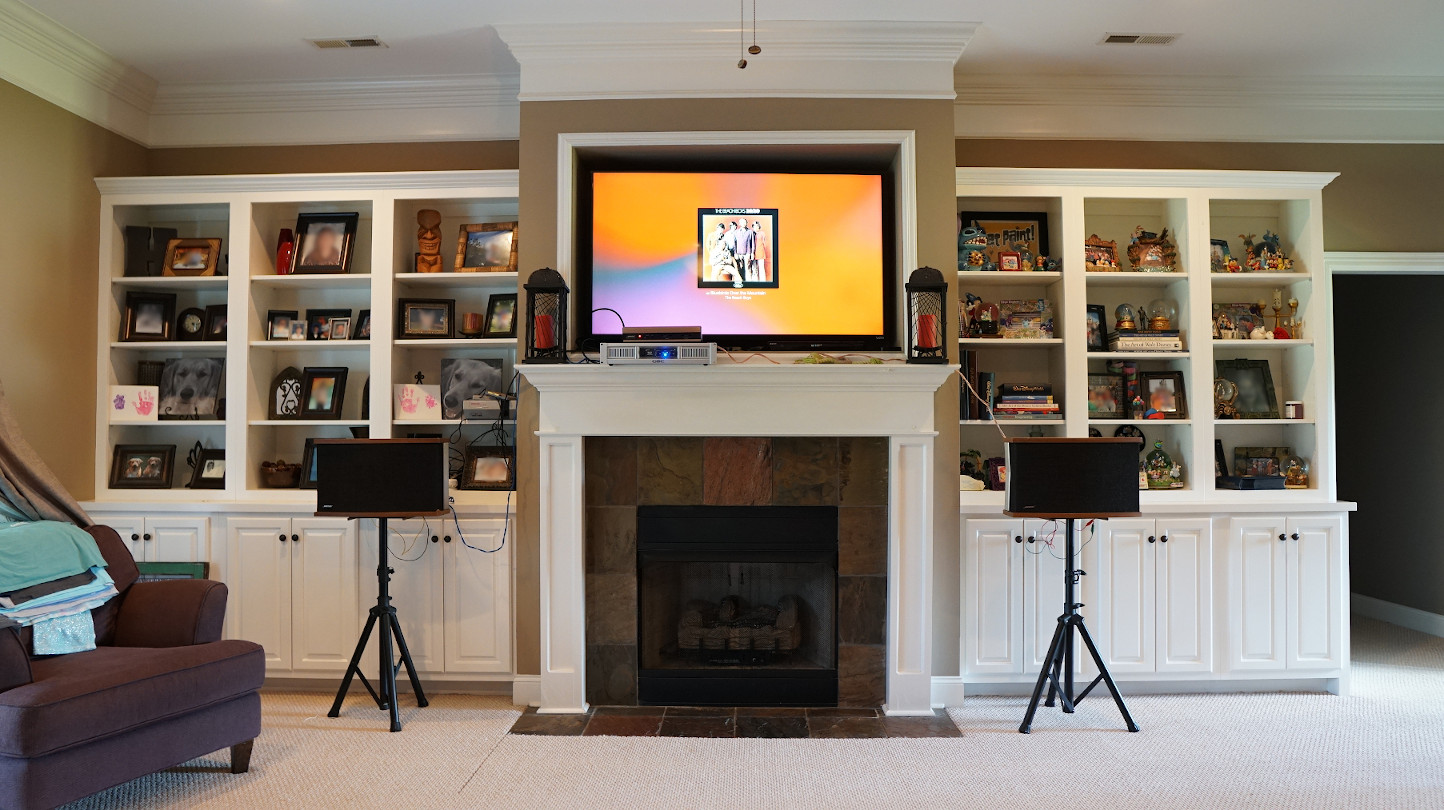
Primary Listening space:
Note that I provide two images of the listening setup. I initially tried the speakers close to the side walls and then I moved them about 3 feet from the side walls.
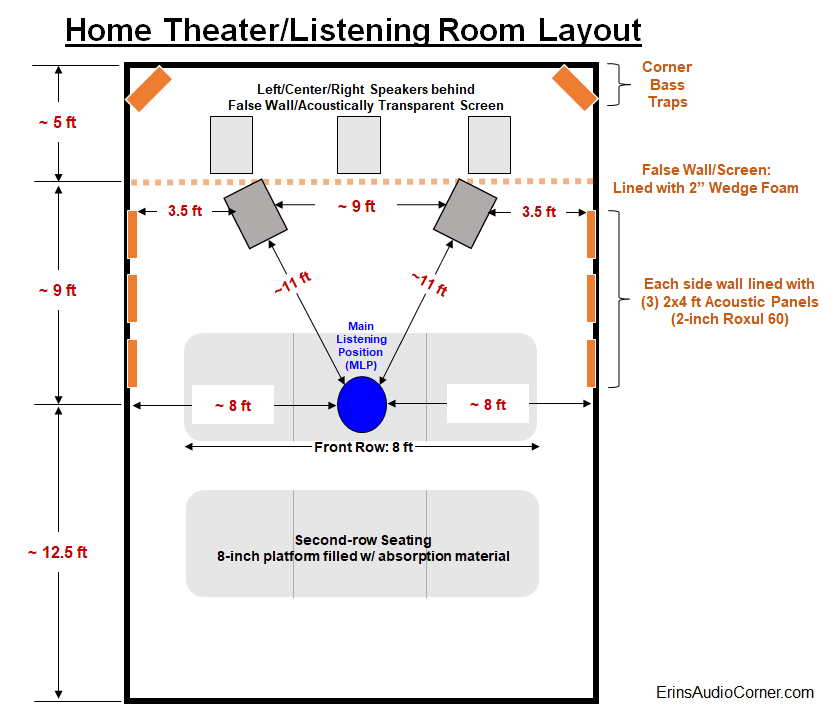
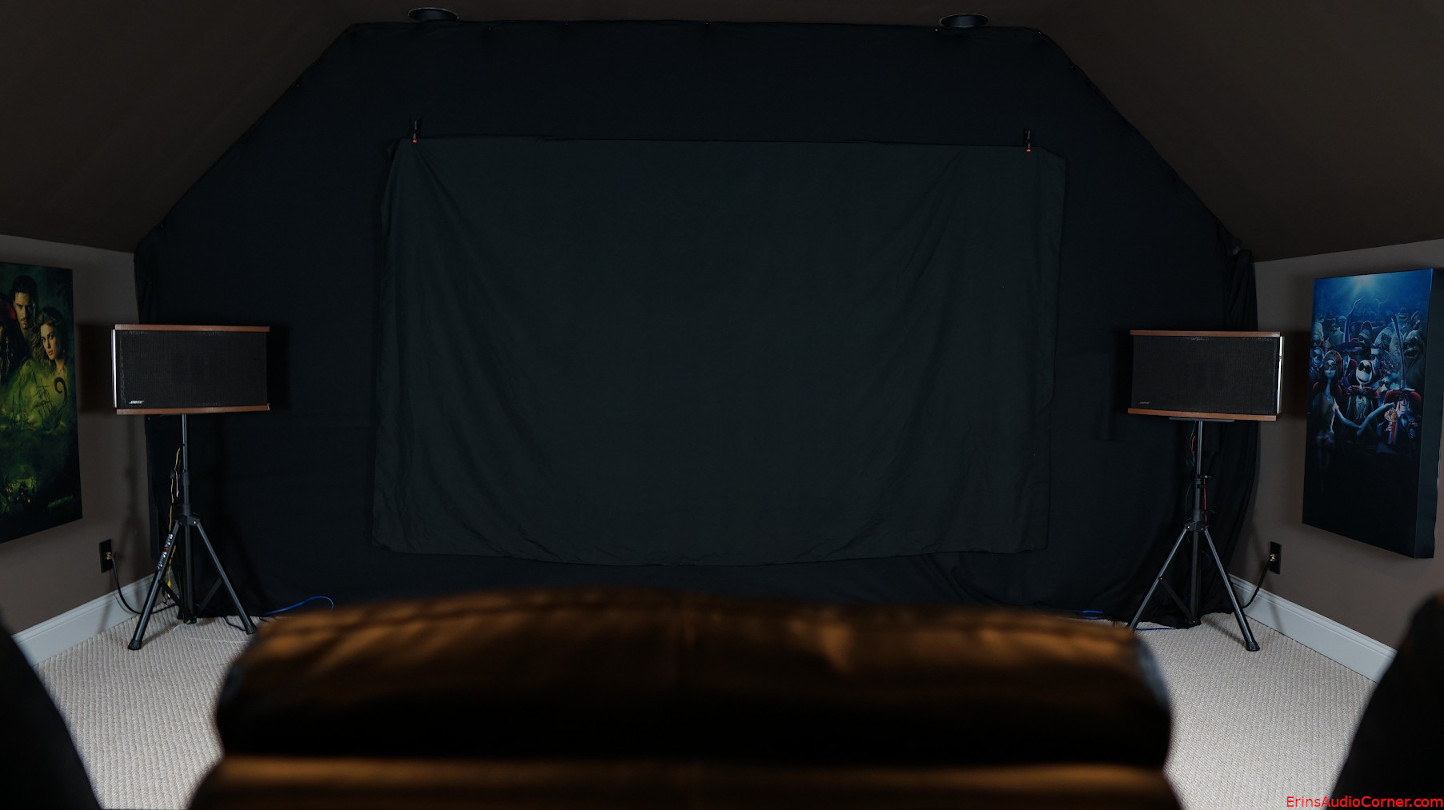
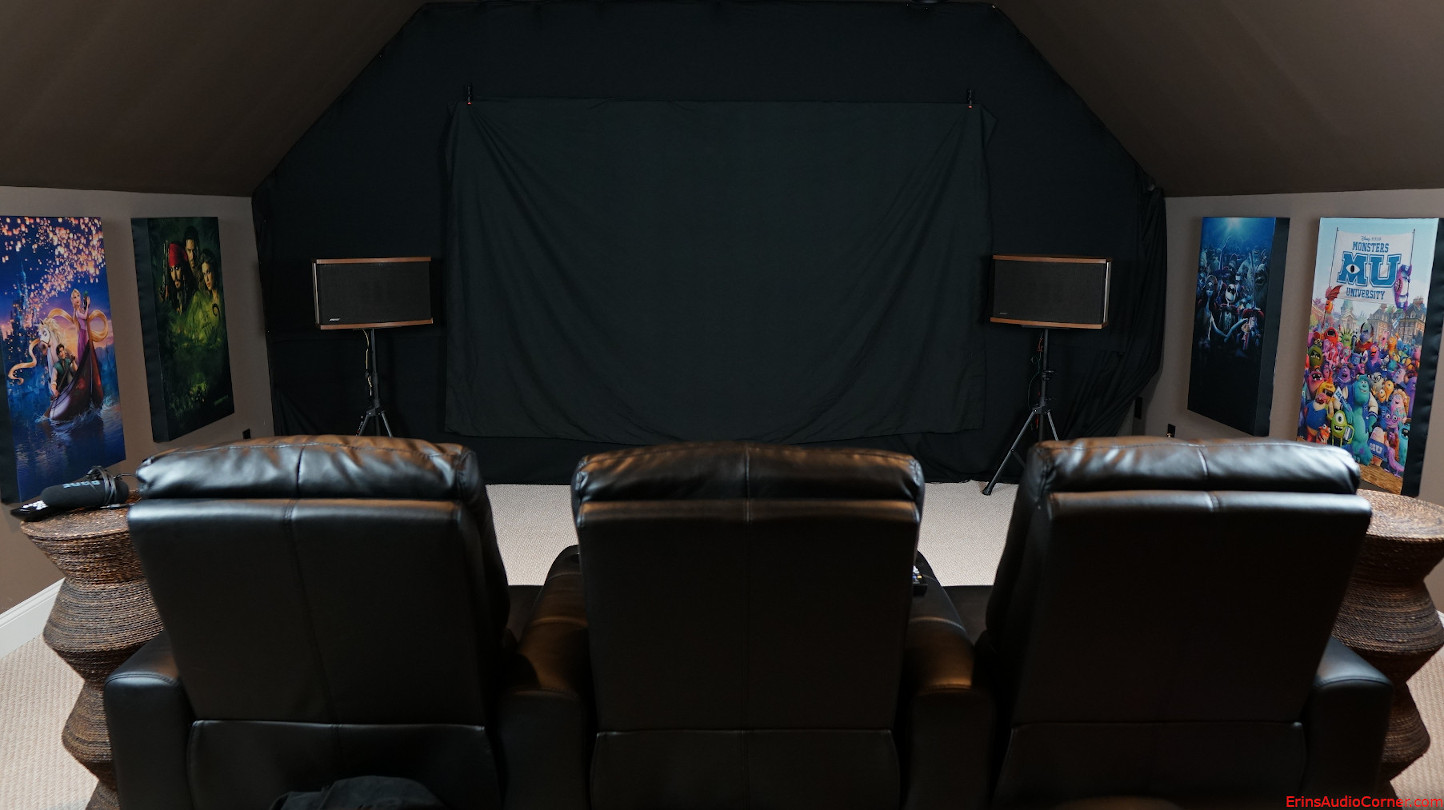
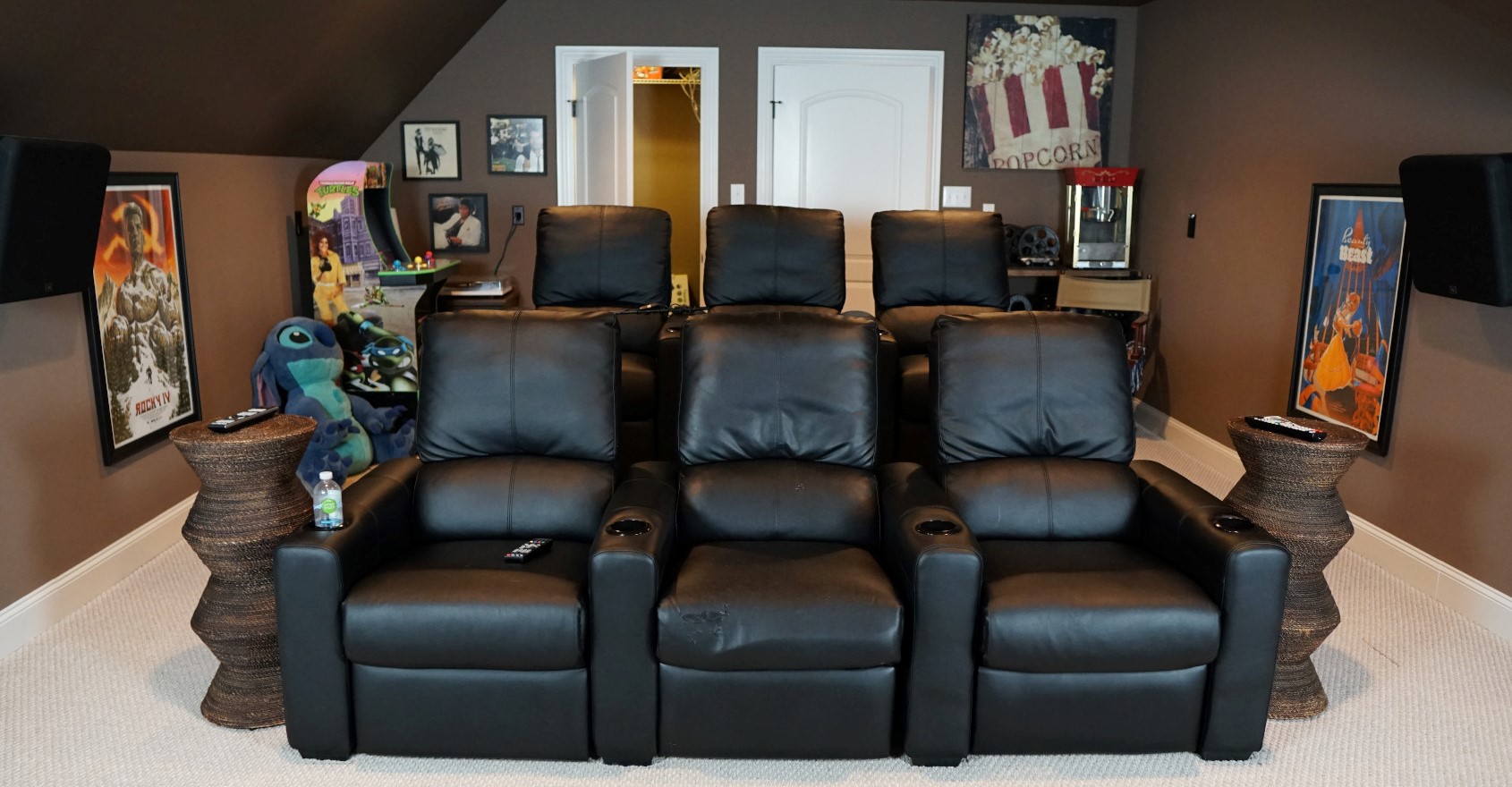
If the false wall part is odd to you, here's some background. I don't like seeing speakers when watching a movie. So, I built a false wall and used an acoustically transparent screen with speakers behind it. The wall is only 2x4's; no panels of wood or anything. Just a skeleton of a wall to give me something to attach the screen and acoustic treatment to. There is 2-inch wedge foam affixed to the 2x4 studs and between the false wall and back of the room are the front speakers (L/C/R & 18-inch subwoofers).
My demo music:
| Title | Artist | Album |
|---|---|---|
| Enjoy The Silence | Depeche Mode | Best Of Depeche Mode, Vol. 1 |
| Higher Love | Steve Winwood | Back In The High Life (MFSL UDCD-611) |
| 24K Magic | Bruno Mars | 24K Magic |
| Magic | The Cars | Heartbeat City (MFSL) |
| Everlasting Love | Howard Jones | The Best of Howard Jones |
| Kodachrome | Paul Simon | There Goes Rhymin’ Simon |
| Everybody Wants To Rule The World | Tears for Fears | Songs from the Big Chair (2014 Deluxe Edition - Disc 1) |
| Know Your Enemy | Rage Against The Machine | Rage Against The Machine (Hybrid SACD) |
| Doo Wop (That Thing) | Lauryn Hill | The Miseducation of Lauryn Hill |
| Tell Yer Mama | Norah Jones | The Fall |
| Don’t Save Me | HAIM | Days Are Gone |
| He Mele No Lilo | Mark Keali’i Ho’omalu and Kamehameha Schools Children’s Chorus | Lilo And Stitch |
| Wrapped Around Your Finger | The Police | Synchronicity |
| Sledgehammer | Peter Gabriel | So |
| Feel It Still | Portugal. The Man | Woodstock |
| Free Fallin | John Mayer | Where The Light Is |
| Whiplash | The Swampers | Muscle Shoals Has Got The Swampers |
Note: I don’t generally audition speakers with the typical “audiophile” music. I have thousands of high-quality albums ranging from pop to metal to jazz and all around. I don’t typically listen to “audiophile” music because I just don’t enjoy it. It is far more important that your evaluation music be something you are familiar with than it is to be esoteric for the sake of being esoteric. You also want to listen to music you enjoy because auditioning a stereo system shouldn’t feel like a chore. Such is the case in my evaluations. Besides, the subjective evaluation is purely to help tie to the objective data and make sense of what I am hearing to help you all get an understanding of how relevant the data is. As you will see below, my music selection did a great job at providing enough range for me to identify the issues that readily appear in the data.
Subjective Analysis Setup:
- The EQ was always in-line in my listening sessions. I only measured them without to get an idea of the raw speaker performance. But I listened to them with the EQ.
- I listened to these various ways: with the speakers near the side wall, with the speakers 3 feet from the sidewalls. With and without Dirac Live. I will make notes where applicable to define the specific listening conditions.
- I used Room EQ Wizard (REW) and my calibrated MiniDSP UMIK-1 to get the volume on my AVR relative to what the actual measured SPL was in the MLP (~11 feet from the speakers). I varied it between 85-90dB, occasionally going up to the mid 90’s to see what the output capability was. In a poll I found most listen to music in this range.
- Components: Oppo BDP-103 playing music off my thumb drive feeding signal via HDMI to a Denon AVR-X4000 which then feeds in to a refurbished Adcom GFA-545 for power.
I listened to these speakers and made my subjective notes before I started measuring objectively. I did not want my knowledge of the measurements to influence my subjective opinion. This is important because I want to try to correlate the objective data with what I hear in my listening space in order to determine the validity of the measurement process. I try to do a few listening sessions over a couple days so I can give my ears a break and come back “fresh”.
First listening test. Without Dirac Live.
I tried various EQ settings and measured the in-situ response. Here are the ones I captured using REW:
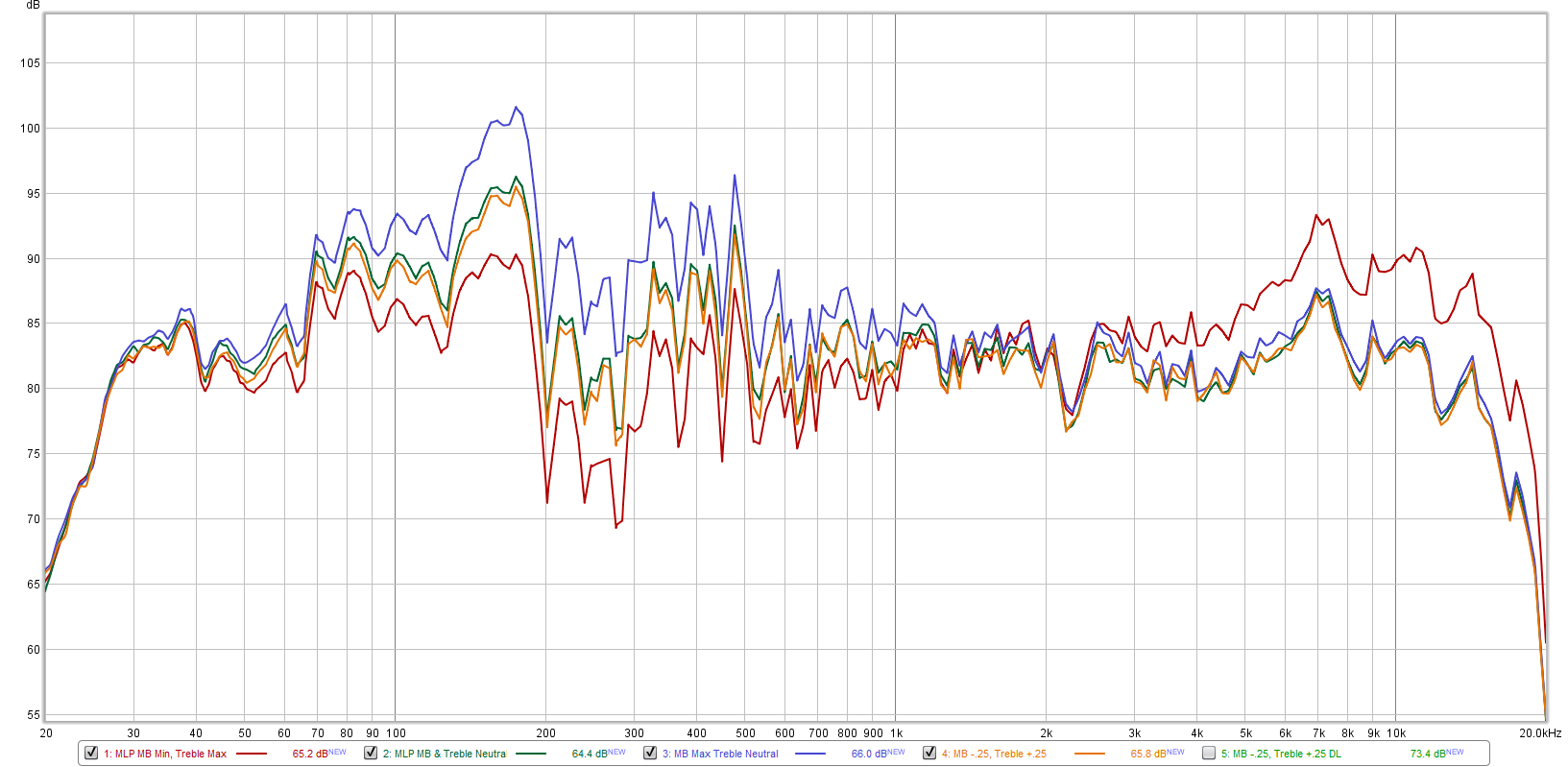
I decided that I liked the almost-neutral setting where the difference was just a touch lower on the MidBass slider and a touch more on the MidTreble slider which is the orange line above.
There are still so many variations that I listened to this speaker in (against the side wall, away, changing EQ, leaving it flat) that I think it might be better to give some general notes rather than specify each individual situation and note the differences. So I’ll do that.
- This speaker displayed significant distortion when pushed in to the mid-90’s at my listening position. It was most aggressive in the midrange between 200-800Hz.
- The imaging and soundstage of this speaker is like nothing I’ve ever heard before. It doesn’t immerse you. But it immerses the area where the speakers are. Typically a soundstage will extend to the side, frontwards and backwards of the speaker. But only with certain music does the soundstage really expand (as it should, of course). However, with the 901’s the soundstage is deep and wide on everything I threw at it. It still changed the size depending on the recording, though.
- Seating position practically doesn’t matter. I know we all talk about speakers having a wide sweet spot. Well, these don’t even have a sweet spot. When I sat in the side chairs of my front row the vocalist still came from between the two speakers. I would hear things now and again where the vocalists’ voice would move at a certain frequency. But compared to what happens when you move a seat over; where the vocalist follows you… well, the 901’s do not do that. The center stays at the center (for the most part). It’s mind-boggling.
- Even when using the best compromise of the EQ sliders, this speaker was a wreck, tonally speaking. There were sharp upper treble tones. The enclosure sounded very boomy and made listening to male vocals at any appreciable volume nearly unbearable. I wrote in my notes from listening that the midrange between 500-800Hz seemed “recessed”. I’m looking at the data and the only thing I can make the connection to is the fact that the lower midrange/upper midbass is so high in output that it makes the upper midrange sound this way.
- I switched the Philharmonic BMR speakers back in for these and was quickly reminded of everything the Bose 901’s do wrong. But I was also reminded of everything a conventional speaker just cannot do.
Second listening test. With Dirac Live.
I took the setting above and let Dirac Live do its thing. It smoothed the response right out and I got this at the measurement position.
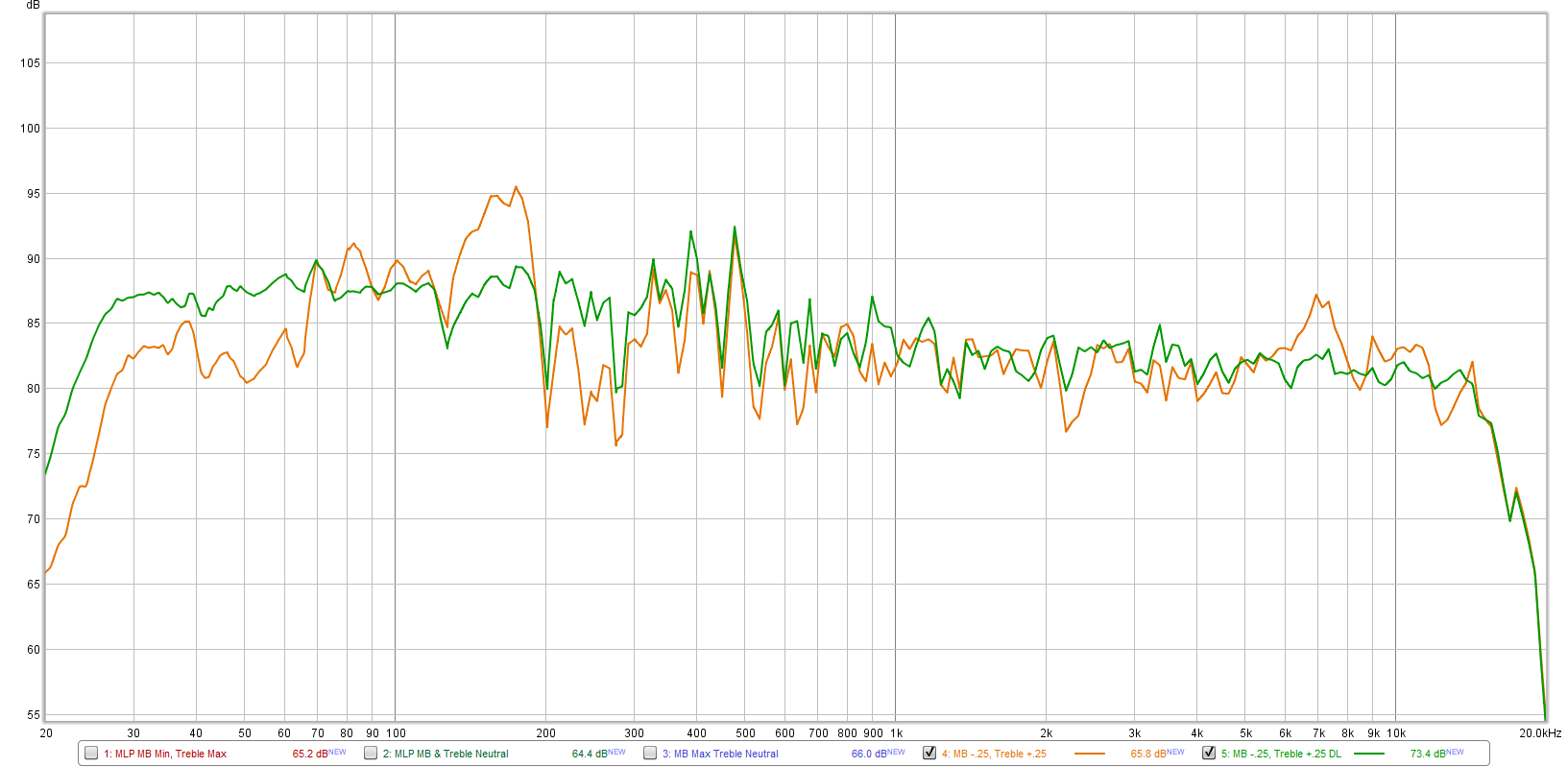
There. That’s better. A lot better, tonally. Still, the distortion was present so they couldn’t be pushed that hard. Even when using a crossover of 80Hz. Which stinks. But if you own a pair of these and want to improve the sound get yourself Dirac Live. I recommend MiniDSP’s products. A simple MiniDSP DDRC-24 as the conduit for Dirac Live to do its thing will make a significant improvement.
Bottom Line
Look, this speaker isn’t a speaker you buy for accuracy. This is the speaker you buy because you’re looking for something different.
I honestly was enamored with what they do. It was so wildly different than anything I’ve heard before that, at first, I pretty much ignored all its flaws (and there are some big ones). The soundstage is crazy big. The sound comes from everywhere in front of you, but still does a good job of having good image placement. It’s not a “wall of sound”. It’s a “prism of sound”. It’s not 2-D (and, really, even some of the best speakers still don’t render a 3-D space). The 901 isn’t even 3-D. It’s 4-D. Heck, it’s 6-D. It’s a total mind trip. But the tonality is a wreck. Dirac Live fixed that up well for me, though. Unfortunately, there’s no way to get around the considerably high distortion and SPL limitations. I wonder how a design like this could be made to sound if you just replace the front full range speaker with a modern 5-inch midrange and tweeter.
If you haven’t heard the Bose 901 speakers, I encourage you to find a pair and give them a listen. If for no other reason than to understand what else is possible. Because if this speaker’s performance could be improved tonally and its SPL limits increased, I believe there would be a lot of people interested. Myself included. So, ask around… you probably have a friend with a pair that would be happy to let you hear what this whole direct/reflecting thing is all about. Don’t expect to be wowed. But maybe expect to smile and laugh a few times when they do something you’ve never heard a speaker do. I know I did.
Support the Cause
If you like what you see here and want to help support the cause you might be interested in joining my Patreon, here. You can also contribute via PayPal (the big yellow button below).
Your support helps me pay for new items to test, hardware, miscellaneous items and costs of the site’s server space and bandwidth. All of which I otherwise pay out of pocket. So, if you can help chip in a few bucks, know that it is very much appreciated.
